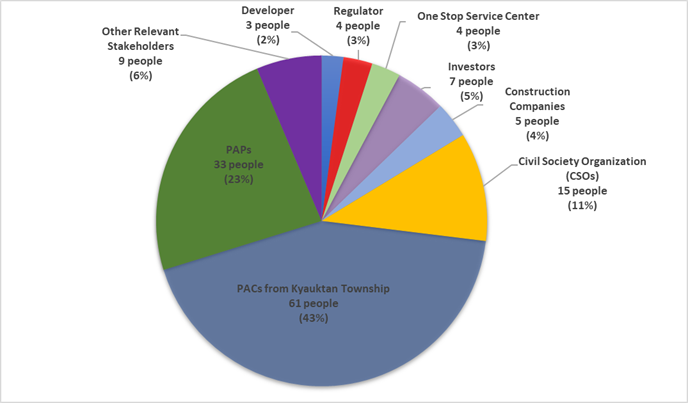
Basic concept of TCMP for its operation
TCMP is designed to support stakeholders to raise questions or concerns with the Thilawa Thilawa Special Economic Zone (TSEZ) and have them addressed in a prompt and respectful manner. The basic concept of TCMP is sumarised in the following page: THILAWA COMPLAINT MANAGEMENT PROCEDURE (TCMP )
TCMP has following principle for the operation:
- Meet requirements of international good practice. Ensure proper documentation of complaints and any corrective actions taken;
- Contribute to continuous improvement in performance through the analysis of trends and lessons learned;
- Identify and monitor stakeholder concerns to support effective stakeholder and risk management;
- Meet requirements of international good practice.
Preparation Process until Formulation of Existing TCMP
Preparing of Existing TCMP
Although Thilawa SEZ used to implement Complaint Management Process, it was updated as per the existing TCMP based on the review by the Japan International Cooperation Agency (JICA) Expert Team in October, 2017.
Consultation and engagement with TSMC, Myanmar Japan Thilawa Development Ltd. (MJTD) and community representatives such as Project Affected Community (PACs) and Project Affected Person (PAPs), were included, as shown in the following table. From the exercises such as document review, key informant interview and multiple group discussions, issues such as operation structure and documentation were identified.

Following pictures shows the investigative meetings held in October 2017
 |  |  |
| [ Meeting with Village Tract level of PAC ] | [ Meeting with Zone A PAPs ] | [ Meeting with Zone B PAPs ] |
Design process with community
During the development of existing TCMP, channels to receive complaints, methods of rolling out of TCMP and draft application form were discussed with Zone A and Zone B PAPs, local communities from PACs, Civil Society Organizations (CSO) and investors through a series of Thilawa Community Coordination (TCC) meetings initiated by MJTD and small group discussion at their places in November, 2017 as shown in the following pictures. The results of community and stakeholders consultation discussion have been reflected in the preparation of existing TCMP.



Rollout of TCMP
A series of TCMP rollout to Community, CSOs, investors and construction companies during November 2017 to October 2018 were undertaken. A flyer about TCMP was distributed to participants and a presentation about TCMP in Myanmar language was used during rollout of TCMP. The list of stakeholders involved during this stage is shown in the table below.
[ TCMP Rollout Record ]




Pilot Implementation of TCMP
Pilot TCMP implementation using TCMP processes to investigate and resolve complaints has been undertaken since November 2017. Community Relation Team (CRT) and responsible parties were trying to resolve various types of complaints such as compensation, livelihood restoration, resettlement/relocation site, environment, infrastructure, traffic/transport, employee/worker behaviour, labour (eg., recruitment, salary, working hours/condition, etc.) and other items in coordinating with Complainants according to TCMP. Based on the difficulties faced during implementation of TCMP, TCMP design was updated for smooth and effective operation.
Summary of TCMP Resolution Report
Complaints since November 2017 which including the previous Complaint Management Process and existing TCMP have been managed with a database and summary of the review was published in September 2018.
The following shows the key findings.
(i) Complaints by Type of Complaint
The total number of complaints has been categorized with the type of complaints as shown in the following figure. Among total number of complaints, compensation related complaint is the most followed by labour related complaints: e.g. payment issue between contractors and sub-contractors, employment issue, ferry car rental person and an investor, etc.. The next is environment related issues such as air pollution due to dust, solid waste, odour and flooding. PAPs from Resettlement Site of Zone B complained about livelihood restoration such as promotion of job opportunities and about Resettlement site such as water supply, road and management of solid waste.

(ii) Complaints by the Status of Complaint Resolution
The status of complaints resolution is shown in the following table. 70 % of complaints are resolved successfully and closed out, out of 50 numbers of complaints. The percentage of conditionally resolved complain was is 22 %. Conditionally resolved was used when complaints where it has not been possible to reach an agreed resolution, or the complainant is not contactable after two months following the receipt of a complaint, and efforts to trace his/her whereabouts have been unsuccessful. The percentage of under investigation – on track is 6 % and resolution is expected to be readily agreed and resolved. The percentage of under investigation – concern is 2 % and resolution is difficult to agree and/or complainant unlikely to agree to a resolution.
[ Number of Complaints by Resolution Status ]

(iii) Complaints by Complainant Type
Complainant type is categorized as PAP who were eligible for compensation in Thilawa SEZ, resident of People Affected Community (PAC), Public, Local employee and other. Residents of PAC are persons living in the following Village Tract/Township in Thanlyin Township and in Kyauktan Township.
[ Living Place of Complainants ]

The number of complaints by complainant type is described in the following table. 56 % of complainants are complaints by residents of People Affected Community (PAC) followed by 28 % of complainants by PAP of Local Employee at SEZ. The percentage of complainant from PAP is 16 %.
[ Complainants Relationship to TSEZ ]

(i) Complaints by Location of Complaints happened
The number of complaints by location is described in the following and figure. The location where the complaints occurred mostly is Thilawa SEZ (Zone A), where most factories are
under operation, and the percentage of complaints occurred in Project Affected Community (PAC) is 34 % followed by the complaints occurred in PAC and in Thilawa SEZ (Zone B) and Resettlement site (Zone A) are 28 % each. The number of complaints in Relocation Site (Zone B) is 10 %.
[ The Number of Complaints by Location ]

